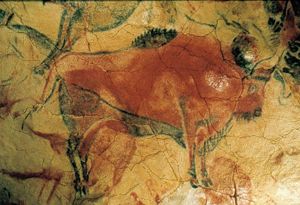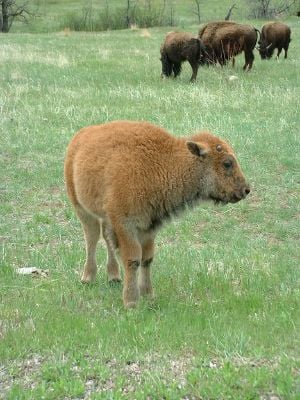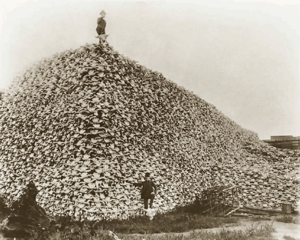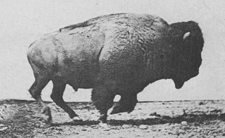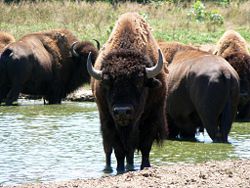Difference between revisions of "Bison" - New World Encyclopedia
| Line 38: | Line 38: | ||
Bison are strictly herbivores. American bison, which live mainly in grassslands, are grazers while European bison, living mainly in forests, are browsers. American bison migrate over the grassland to reach better conditions. In the past herds of millions traveled hundreds of miles seasonally to take advantage of different growing conditions. This gave the [[grass]] a chance to recover and regrow. The bisons' droppings and urine fertilized the soil, returning needed [[nitrogen]] (Lott 2002). | Bison are strictly herbivores. American bison, which live mainly in grassslands, are grazers while European bison, living mainly in forests, are browsers. American bison migrate over the grassland to reach better conditions. In the past herds of millions traveled hundreds of miles seasonally to take advantage of different growing conditions. This gave the [[grass]] a chance to recover and regrow. The bisons' droppings and urine fertilized the soil, returning needed [[nitrogen]] (Lott 2002). | ||
| − | Bison are subject to various parasites, among them the winter tick, ''Dermacentor albipictus'', a single one of which can reduce a calf's growth by 1.5 lbs (.7 kg) due to the blood it takes. Bison roll in dirt in order to remove ticks and other parasites. | + | Bison are subject to various parasites, among them the winter tick, ''Dermacentor albipictus'', a single one of which can reduce a calf's growth by 1.5 lbs (.7 kg) due to the blood it takes. Bison roll in dirt in order to remove ticks and other parasites. This also helps them to keep cool in hot weather (Lott 2002). |
One animal that has a mutually beneficial [[symbiosis|symbiotic]] relationship with the American bison is the Black-tailed prairie dog, ''Cynomys ludovicianus'', a small [[rodent]]. Prairie dogs eat the same grass as the bison and live in large groups in underground tunnels called "towns". Bison are attracted to prairie dog towns by the large mounds of dirt removed from the tunnels which the bison use to roll in. They benefit the prairie dogs by eating the tall grass and fertilizing the soil, both of which promote the growth of the more nutritious new short grass (Lott 2002). | One animal that has a mutually beneficial [[symbiosis|symbiotic]] relationship with the American bison is the Black-tailed prairie dog, ''Cynomys ludovicianus'', a small [[rodent]]. Prairie dogs eat the same grass as the bison and live in large groups in underground tunnels called "towns". Bison are attracted to prairie dog towns by the large mounds of dirt removed from the tunnels which the bison use to roll in. They benefit the prairie dogs by eating the tall grass and fertilizing the soil, both of which promote the growth of the more nutritious new short grass (Lott 2002). | ||
| − | Because of their large size and strength bison have few predators. | + | Because of their large size and strength bison have few predators. In both America and Europe [[wolf|wolves]], ''Canis lupus'', are the most serious predator of bison (besides [[human]]s). The wolves' habit of hunting in groups enables them to prey on animals much larger than themselves. But most often it is the calves that fall victim to wolves. It has been suggested that the bison's tendency to run away from predators rather than standing and fighting like many other bovines, including probably the extinct bison species, has given them a better chance against wolves and later human hunters. The Brown [[bear]] (''Ursus arctos''), called the Grizzly bear in North America, also eats bison but is too slow to catch healthy, alert adult bison so mainly eats those that have died from cold or disease (Lott 2002). |
| + | |||
| + | ==Bison and humans== | ||
| + | [[Image:Altamira Bison.JPG|thumb|Prehistoric painting of a bison from cave in Altamira, Spain]] | ||
| + | |||
| + | Bison were an important prey for human hunters from prehistoric times. | ||
Revision as of 23:14, 11 November 2006
| Bison | ||||||||||||||
|---|---|---|---|---|---|---|---|---|---|---|---|---|---|---|
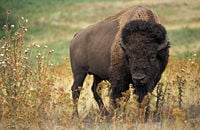 {{{caption}}} | ||||||||||||||
| Scientific classification | ||||||||||||||
| ||||||||||||||
| Species | ||||||||||||||
|
B. bison |
Bison are members of the genus Bison of the Bovid family of the even-toed ungulates, or hoofed mammals. There are three types of living bison:
- The American bison (Bison bison bison), the most famous bison, formerly one of the most common large animals in North America
- The Wood bison (Bison bison athabascae), considered to be a subspecies of the American bison
- The European bison or Wisent (Bison bonasus)
There were also several other species of bison which became extinct within the last 10,000 years.
Bison are very closely related to cattle, yaks, true buffalo, and other members of the subfamily Bovinae, or bovines.
Bison physiology and behavior
Bison are among the largest of hoofed mammals, standing 1.5 to 2 meters (5 to 6.5 feet) at the shoulder and weighing 350 to 1000 kg (800 to 2,200 lbs). Males average larger than females. The head and forequarters are especially massive with a large hump on the shoulders. Both sexes have horns with the male's being somewhat larger. (Nowak 1983).
Bison mature in about two years and have an average life span of about twenty years. A female bison can have a calf every year with mating taking place in summer and birth in spring when conditions are best for the young animal. Male bison fight with each other over the right to mate with females. The male bison's greater size, larger horns, and thicker covering of hair on the head and front of the body benefit them in these struggles. In many cases the smaller, younger, or less confident male will back down and no actual fight will take place. (Lott 2002).
The bison's place in nature
Bison are strictly herbivores. American bison, which live mainly in grassslands, are grazers while European bison, living mainly in forests, are browsers. American bison migrate over the grassland to reach better conditions. In the past herds of millions traveled hundreds of miles seasonally to take advantage of different growing conditions. This gave the grass a chance to recover and regrow. The bisons' droppings and urine fertilized the soil, returning needed nitrogen (Lott 2002).
Bison are subject to various parasites, among them the winter tick, Dermacentor albipictus, a single one of which can reduce a calf's growth by 1.5 lbs (.7 kg) due to the blood it takes. Bison roll in dirt in order to remove ticks and other parasites. This also helps them to keep cool in hot weather (Lott 2002).
One animal that has a mutually beneficial symbiotic relationship with the American bison is the Black-tailed prairie dog, Cynomys ludovicianus, a small rodent. Prairie dogs eat the same grass as the bison and live in large groups in underground tunnels called "towns". Bison are attracted to prairie dog towns by the large mounds of dirt removed from the tunnels which the bison use to roll in. They benefit the prairie dogs by eating the tall grass and fertilizing the soil, both of which promote the growth of the more nutritious new short grass (Lott 2002).
Because of their large size and strength bison have few predators. In both America and Europe wolves, Canis lupus, are the most serious predator of bison (besides humans). The wolves' habit of hunting in groups enables them to prey on animals much larger than themselves. But most often it is the calves that fall victim to wolves. It has been suggested that the bison's tendency to run away from predators rather than standing and fighting like many other bovines, including probably the extinct bison species, has given them a better chance against wolves and later human hunters. The Brown bear (Ursus arctos), called the Grizzly bear in North America, also eats bison but is too slow to catch healthy, alert adult bison so mainly eats those that have died from cold or disease (Lott 2002).
Bison and humans
Bison were an important prey for human hunters from prehistoric times.
The American Bison was depicted on the reverse side of the U.S. "buffalo nickel" from 1913 to 1938. In 2005, the United States Mint coined a nickel with a new depiction of the bison as part of its "Westward Journey" series; the Kansas and North Dakota quarters have a depiction of the bison on its reverse as part of its "50 State Quarter" series. The Kansas State Quarter only has the bison and does not feature any writing. The North Dakota State Quarter has two bison.
The bison is a symbol of Manitoba, the Royal Canadian Mounted Police, Bucknell University, the University of Colorado, Lipscomb University, Harding University, Marshall University, the Independence Party of Minnesota, and North Dakota State University. It is also commonly used as a symbol of the city of Buffalo, New York and its professional sports teams, the Buffalo Bills and Buffalo Sabres, although the city was not named for the animal. The bison is also the state mammal of Wyoming. It is the state animal of Kansas (see Governor of Kansas Quick Facts).

ReferencesISBN links support NWE through referral fees
- Intertribal Bison Cooperative (IBC). 2006. Website[1]
- Lott, D.F. 2002. American Bison. Berkeley, California, USA : University of California Press
- National Bison Association (NBA). 2006 Website[2]
- Nowak, R.M. and Paradiso, J.L. 1983. Walker's Mammals of the World. Baltimore, Maryland, USA : The Johns Hopkins University Press
- Voelker, W. 1986. The Natural History of Living Mammals. Medford, New Jersey, USA : Plexus Publishing, Inc.
Credits
New World Encyclopedia writers and editors rewrote and completed the Wikipedia article in accordance with New World Encyclopedia standards. This article abides by terms of the Creative Commons CC-by-sa 3.0 License (CC-by-sa), which may be used and disseminated with proper attribution. Credit is due under the terms of this license that can reference both the New World Encyclopedia contributors and the selfless volunteer contributors of the Wikimedia Foundation. To cite this article click here for a list of acceptable citing formats.The history of earlier contributions by wikipedians is accessible to researchers here:
The history of this article since it was imported to New World Encyclopedia:
Note: Some restrictions may apply to use of individual images which are separately licensed.
